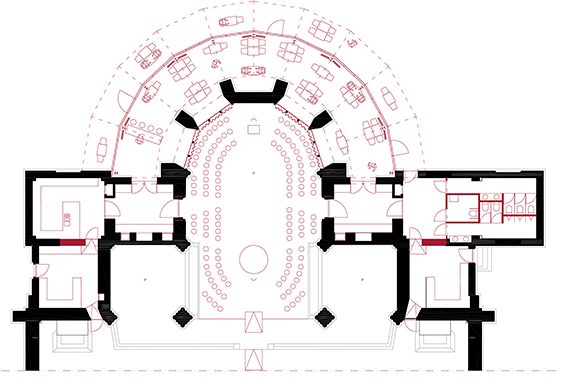‘Wherever a few should gather’
The Liturgical Movement and Vatican II as a source for architectural transformation of churches in the context of adaptive reuse
DOI:
https://doi.org/10.17979/aarc.2020.7.0.6289Keywords:
adaptive reuse, Liturgical Movement, Vatican II, community, research by designAbstract
Due to a process of secularization many parish communities need to redefine their church use, reducing the liturgical space and bringing in other functions. In this contribution, we elaborate on the process of adapting existing churches to this reality. We argue that the spatial concepts developed by the Liturgical Movement in the context of Vatican II can become sources of inspiration. First, we define the relevant characteristics of the reform, instigated by figures like theologian Romano Guardini and architect Rudolf Schwarz. Second, we show how these characteristics can be applied in the case study of the Magdalena church in Bruges (Belgium). Rather than restoring the 19th century Gothic Revival church, we tried to translate its typology and layered quality into a contemporary space for liturgy and community, while at the same time opening up the church to its environment.
Downloads
Metrics
References
Baisier, Claire. 2016. Divine Interiors: Experience Churches in the Age of Rubens: Exhibition Guide. Mayer van den Bergh Museum: Stad Antwerpen.
Bekaert, Geert. 1967. In een of ander huis: kerkbouw op een keerpunt. Tielt/The Hague: Lannoo.
Beauduin, Lambert. 2010. «La vraie prieire de l’Église». Questions Liturgiques/Studies in Liturgy 91/1: 37–41.
Bouyer, Louis. 1954. Liturgical Piety. Notre Dame: University of Notre Dame Press.
Debuyst, Frédéric. 1968. Modern Architecture and Christian Celebration. Ecumenical Studies in Worship 18. London: Lutterworth Press.
Debuyst, Frédéric. 1997. Le genie chrétien du lieu. Paris: Cerf.
Debuyst, Frédéric. 2008. L’entrée en liturgie: Introduction à l’oeuvre liturgique de Romano Guardini. Paris: Cerf.
Grafe, Christoph. 1997. «Kale waarheid: Fysieke ervaring en essentie in de architectuur van Rudolf Schwarz». OASE 45/46: 3-27.
Guardini, Romano. 1947 (1939). Besinnung vor der Feier der Heiligen Messe. Mainz: Matthias-Grünewald.
Guardini, Romano. 2007 (1918). Vom Geist der Liturgie. Augsburg: Grünewald/Schöningh.
Haquin, André. 2005. «The Liturgical Movement and Catholic Ritual Revision». In The Oxford History of Christian Worship, edited by Geoffrey Wainwright and Karen B. Westerfield Tucker, 696-720. New York: Oxford University Press.
Höslinger, Norbert and Theodor Maas-Ewerd. 1979. Mit Sanfter Zahigkeit: Pius Parsch Und Die Biblisch-Liturgische Erneuerung. Schriften Des Pius-Parsch-Instituts Klosterneuburg, 4. Klosterneuburg: Österreichisches Katholisches Bibelwerk.
Jungmann, Josef. 1951 (1949). The Mass of the Roman rite: its Origins and Development (Missarum Sollemnia). Translated by Francis A. Brunner. New York: Benzinger.
Morel, Anne-Françoise and Stephanie Van de Voorde. 2012. «Rethinking the Twentieth-Century Catholic Church in Belgium: the Inter-Relationship Between Liturgy and Architecture». Architectural History 55: 269-297.
Panofsky, Erwin and Gerda Panofsky-Soergel. 1979. Abbot Suger on the Abbey Church of St. Denis and its Art Treasures. Princeton: Princeton University Press.
Reid, Alcuin. 2016. «The Twentieth-Century Liturgical Movement». In T&T Clarck Companion to Liturgy, edited by Alcuin Reid, 153-174. London/New York: Bloomsbury.
Schwarz, Rudolf. 1958. The Church Incarnate: The Sacred Function of Christian Architecture. Translated by Cynthia Harris. Chicago: Henry Regnery Company.
Schnell, Hugo. 1973. Der Kirchenbau des 20. Jahrhunderts in Deutschland. München & Zürich: Schnell und Steiner.
Vande Keere, Nikolaas, Regis Verplaetse, Saidja Heynickx, Jo Broekx, Marcella Schiepers, Bie Plevoets and Koenraad Van Cleempoel. 2019. Heilige Magdalenakerk Brugge Ontwerpend haalbaarheidsonderzoek nav de transformatie van de Heilige Magdalenakerk voor herwaardering. Report of a commissioned research by design project concerning the Magdalena church, Bruges (Belgium).
Verheul, Ambrosius. 1961. Inleiding tot de liturgie: haar theologische achtergrond. Antwerpen: Patmos.
Woods, Kim W. 2013. Art & Visual Culture 1100-1600: Medieval to Renaissance. Milbank: Tate Enterprises Ltd.
















